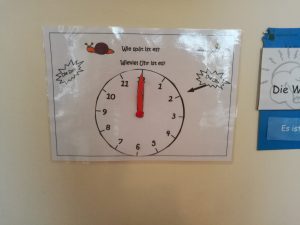Die Zeit/ the time

Practice telling the time in German! Move the hands and let your students read the time. Say the hour and then the minutes. Say the word ‘Uhr’ (time) between the hour and the minutes.
Example:
4:00 Uhr: Es ist 4 Uhr.
4:15 Uhr: Es ist 4 (Uhr) fünfzehn.
4:45 Uhr: Es ist 4 (Uhr) fünfundvierzig.
4:30 Uhr: Es ist 4 (Uhr) dreißig.
Being able to tell the time in German is a useful and fun skill!
Before you teach telling the time it is important to practice the numbers from 1 to 59 with your students. Of course it is important to know all the numbers in German but learning 1-100 is especially important!
Additionally it is crucial to know and practice the following terms:
- viertel nach – quarter past
4.15 Uhr: Es ist viertel nach vier.
- viertel vor – quarter to
4.45 Uhr: Es ist viertel vor fünf.
- halb – half
4.30 Uhr: Es ist halb fünf. (Note: In German it is half way to five and not half way past.)
It is also important to learn the 24 hour clock as it is sometimes used in Germany.
Example:
4. (Uhr) 30 –> Afternoon: 16. (Uhr) 30.
Now it is time to create a little conversation:
You could start off with ‘Entschuldigung, wie spät ist es?‘ – Excuse me, what time is it?
8.30 Uhr: Es ist 8 (Uhr) 30 o d e r Es ist halb neun. (It is half to nine) o d e r Es ist 20 (Uhr) 30. (If it is evening and not morning).
End the conversation with a simple ‘Vielen Dank!’
Other options: ‘Es ist schon so spät!’ – It is already quite late.
Or ‘Es ist so früh!’ – It is so early!
Worksheet:
The worksheet consists of two pages. Cut out the clock/ hands and stick it onto the first page.

‘Wie spät ist es?’ ‘Wieviel Uhr ist es?’ – What time is it?
Die Zeit- the time
Die Minute – the minute
Die Uhr – the watch/ clock
Die Stunde – the hour





